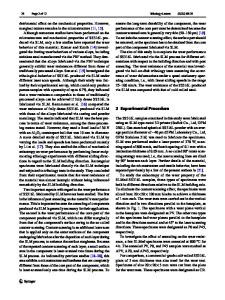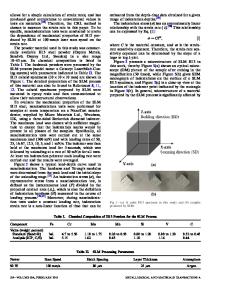Cavitation erosion resistance of 316L stainless steel fabricated using selective laser melting
- PDF / 7,201,188 Bytes
- 19 Pages / 595.22 x 842 pts (A4) Page_size
- 63 Downloads / 320 Views
ISSN 2223-7690 CN 10-1237/TH
RESEARCH ARTICLE
Cavitation erosion resistance of 316L stainless steel fabricated using selective laser melting Hongqin DING1,†, Qing TANG1,†, Yi ZHU1,2,*, Chao ZHANG1, Huayong YANG1 1
State Key Laboratory of Fluid Power and Mechatronic Systems, Zhejiang University, Hangzhou 310027, China
2
Ningbo Research Institute, Zhejiang University, Ningbo 315100, China
Received: 11 April 2020 / Revised: 26 July 2020 / Accepted: 11 August 2020
© The author(s) 2020. Abstract: Cavitation erosion degrades the performance and reliability of hydraulic machinery. Selective laser melting (SLM) is a type of metal additive manufacturing technology that can fabricate metal parts directly and provide lightweight design in various industrial applications. However, the cavitation erosion behaviors of SLM-fabricated parts have rarely been studied. In this study, SLM 316L stainless steel samples were fabricated via SLM technology considering the scanning strategy, scanning speed, laser power, and build orientation. The effect of the process parameters on the cavitation erosion resistance of the SLM-fabricated 316L stainless steel samples was illustrated using an ultrasonic vibratory cavitation system. The mass loss and surface topography were employed to evaluate the surface cavitation damage of the SLM-fabricated 316L stainless steel samples after the cavitation test. The cavitation damage mechanism of the SLM-fabricated samples was discussed. The results show that the degree of cavitation damage of the sample fabricated via SLM with a few defects, anisotropic build direction, and columnar microstructure is significantly decreased. Defects such as pores, which are attributed to low laser power and high scanning speed, may severely aggravate the cavitation damage of the SLM-fabricated samples. The sample fabricated via SLM with a low laser power and exposure time exhibited the highest porosity and poor cavitation erosion resistance. The cellular structures are more prone to cavitation damage compared with the columnar structures. A sample with a high density of grain boundaries will severely suffer cavitation damage. Keywords: selective laser melting; stainless steel; cavitation erosion; process parameters; microstructure
1
Introduction
Cavitation is a common phenomenon initiated by local pressure fluctuations in aqueous environments [1−4]. The formation of cavitation bubbles and their sudden implosion generate a high micro jet and shock wave, leading to a significant mass loss, erosion damage, and premature failure of the material [5−9]. The cavitation erosion phenomenon often occurs in machine components in aqueous media, especially in hydraulic systems, such as † These authors contributed equally to this work. * Corresponding author: Yi ZHU, E-mail: [email protected]
pumps and valves. Furthermore, it will seriously affect the surface performance and shorten the service life due to cavitation damage. Several studies have been conducted on the various aspects of cavitation and cavitation erosion resistan
Data Loading...











